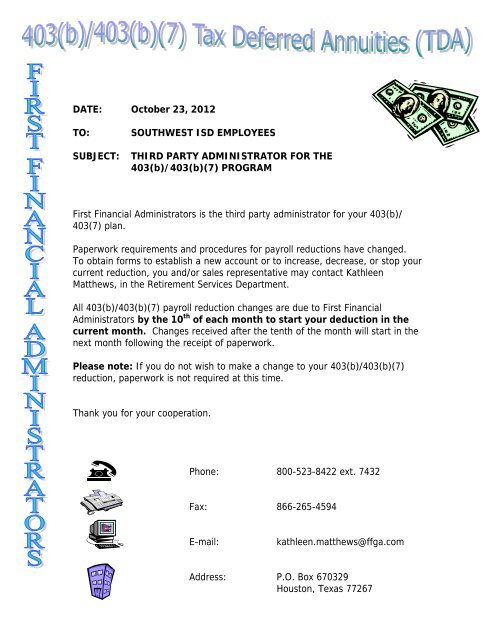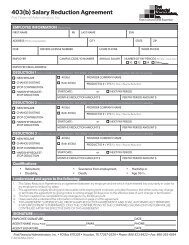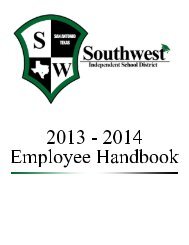403(b) - Southwest ISD
403(b) - Southwest ISD
403(b) - Southwest ISD
Create successful ePaper yourself
Turn your PDF publications into a flip-book with our unique Google optimized e-Paper software.
DATE: October 23, 2012<br />
TO:<br />
SUBJECT:<br />
SOUTHWEST <strong>ISD</strong> EMPLOYEES<br />
THIRD PARTY ADMINISTRATOR FOR THE<br />
<strong>403</strong>(b)/<strong>403</strong>(b)(7) PROGRAM<br />
First Financial Administrators is the third party administrator for your <strong>403</strong>(b)/<br />
<strong>403</strong>(7) plan.<br />
Paperwork requirements and procedures for payroll reductions have changed.<br />
To obtain forms to establish a new account or to increase, decrease, or stop your<br />
current reduction, you and/or sales representative may contact Kathleen<br />
Matthews, in the Retirement Services Department.<br />
All <strong>403</strong>(b)/<strong>403</strong>(b)(7) payroll reduction changes are due to First Financial<br />
Administrators by the 10 th of each month to start your deduction in the<br />
current month. Changes received after the tenth of the month will start in the<br />
next month following the receipt of paperwork.<br />
Please note: If you do not wish to make a change to your <strong>403</strong>(b)/<strong>403</strong>(b)(7)<br />
reduction, paperwork is not required at this time.<br />
Thank you for your cooperation.<br />
Phone: 800-523-8422 ext. 7432<br />
Fax: 866-265-4594<br />
E-mail:<br />
kathleen.matthews@ffga.com<br />
Address: P.O. Box 670329<br />
Houston, Texas 77267
TDA - A SMART APPROACH FOR MEETING<br />
YOUR FINANCIAL GOALS!<br />
A Tax Deferred Annuity gives you the opportunity to supplement other retirement savings plans and enjoy favorable<br />
tax advantages along the way.<br />
Q. WHAT IS AN ANNUITY?<br />
A. An annuity is a contractual agreement between you and a life insurance company. In return for the deposits<br />
you make during your working years, the company promises to pay you monthly payments for a designated<br />
period of time. Only a life insurance company can offer an annuity that guarantees payments for life.<br />
Q. WHAT IS A <strong>403</strong>(b)(7)?<br />
A. In 1974, along with other code changes, paragraph (7) was added to Code Section <strong>403</strong>(b). While previously<br />
<strong>403</strong>(b) participants were limited to choosing between fixed and variable annuities, Section <strong>403</strong>(b)(7) added a<br />
third investment option - mutual funds having custodial arrangements with a recognized financial institution.<br />
For the first time, participants were able to take advantage of the financial opportunities of mutual fund<br />
accounts, including the popular “no load” funds.<br />
Q. ARE THERE ANY LIMITS TO HOW MUCH I CAN DEFER EACH YEAR?<br />
A. YES<br />
Provision 2012 2013<br />
402(g) limit on<br />
elective deferrals to<br />
<strong>403</strong>(b) plans<br />
$17,000 $17,500<br />
<strong>403</strong>(b) deferrals for<br />
participants 50 or<br />
older<br />
+ $5,500 + $5,500<br />
Q. WHO SHOULD CONSIDER A TDA?<br />
A. You should investigate a TDA if:<br />
* You pay substantial amounts of federal income taxes.<br />
* You are in a dual income family.<br />
* You are single, with no dependents.<br />
* You are investing money on an after-tax basis for long-term goals.<br />
* You have sufficient emergency funds.<br />
Q. WHY IS A TDA AN IMPORTANT SAVINGS PLAN?<br />
A. Contributions to a TDA are deposited into the plan on a pre-tax basis. In addition, interest earnings<br />
accumulate on a tax-deferred basis.<br />
Revised 10/25/2012
Q. HOW ARE CONTRIBUTIONS MADE?<br />
A. To establish a TDA plan, you must complete an application and a salary reduction agreement form; which,<br />
in effect, reduces your taxable salary. Your employer will automatically reduce your paycheck by the<br />
amount you designate and will contribute that portion to the plan.<br />
Q. IF I BEGIN THE CONTRACT DURING THE MIDDLE OF THE YEAR, IS IT TOO LATE FOR<br />
ME TO PUT IN THE MAXIMUM ALLOWED AMOUNT FOR THE YEAR?<br />
A. No. With your employer’s permission, you can establish your salary reduction agreement to make up for the<br />
months you missed so far. For example, if you wish to deposit $100 a month but did not sign up until June;<br />
you could make your agreement for $200 a month until the end of the year and $100 a month thereafter.<br />
Q. MAY I STOP CONTRIBUTING AT ANY TIME?<br />
A. YES. You may terminate your salary reduction agreement at any time.<br />
Q. WHAT HAPPENS IF I CHANGE JOBS?<br />
A. If you continue with an employer that offers a TDA, you have several options:<br />
1. Continue your contributions with your new employer as long as they are listed as a vendor within<br />
the plan and allow new business.<br />
2. Leave your present contract as is, if the account value is at least $600; and begin a new contract<br />
with a vendor listed in the new employer plan.<br />
3. Transfer the value of your present account to a new contract with a vendor offered by your new<br />
employer. You must verify that the new employer plan allows transfer/rollovers. No taxes will be<br />
due if the transfer is executed properly.<br />
4. Take a lump sum distribution. The distribution amount is includable as income for the year and<br />
taxed accordingly.<br />
5. Choose an annuity option. Annuity payments are taxable as received.<br />
If you do not remain eligible for a TDA, you may choose either option 4 or 5, or:<br />
1. You may transfer your account value to an IRA (IRA Rollover) or other applicable retirement<br />
plan. No taxes will be due if the transfer is executed properly, check with your current vendor as<br />
there may be surrender fees.<br />
2. You may leave your account on paid up status if the account value is at least $600. No taxes will<br />
be due.<br />
Revised 10/25/2012
Q. CAN I HAVE A TDA PLAN IN ADDITION TO OTHER SAVINGS OR RETIREMENT PLANS?<br />
A. YES. You may have a TDA in addition to your IRA. Because federal and state rules and regulations differ<br />
between IRA’s and TDA’s, it is generally agreed that it is best to maximize your TDA contributions before<br />
starting an IRA. You may also be a participant in other savings or retirement plans your employer provides.<br />
Q. IF I PLAN TO RETIRE IN JUST A FEW YEARS, SHOULD I PARTICIPATE IN A TDA PLAN?<br />
A. If you are nearing retirement age, you may be able to make larger salary reductions due to your years of<br />
accumulated past service and thus take maximum advantage of the program until retirement.<br />
Q. CAN I WITHDRAW MONEY FROM MY TDA PLAN?<br />
A. The IRS prohibits withdrawal of elective contributions and earnings on those contributions except for:<br />
* attainment of age 59 ½<br />
* death<br />
* disability<br />
* severance from employment<br />
* financial hardship, (if the plan allows)<br />
If money is withdrawn for one of the above reasons, ordinary income tax must be paid. In addition, the<br />
contract itself may impose withdrawal or surrender charges. Also, a 10% tax penalty may be imposed by the<br />
IRS in certain circumstances. A financial hardship withdrawal will affect you in two additional ways:<br />
1. Your contributions must be suspended for 6 months following the withdrawal; and<br />
2. Your contributions for the year following this 6 month period will be subject to certain limitations.<br />
Q. MAY I TAKE OUT A LOAN WITHOUT HAVING TO PAY TAXES ON IT?<br />
A. Policy loans are permitted by law but must be verified by the employer plan to see if it offers loans. Vendors<br />
and Employers are not obligated to offer a loan provision. If allowed, the maximum loan amount is<br />
generally 50% of account value, not to exceed $50,000, and must be repaid in five years or it will be<br />
considered a taxable distribution.<br />
Revised 10/25/2012
Q. WHEN MUST I BEGIN RECEIVING A DISTRIBUTION FROM MY TDA PLAN?<br />
A. Generally, the IRS requires that a participant must begin receiving retirement benefits no later than April 1<br />
following the year in which the participant reaches age 70 1/2. However, if still employed by an eligible<br />
employer, the participant may defer making withdrawals until April 1 following date of retirement/severance<br />
from service.<br />
Q. WHAT CHOICES DO I HAVE REGARDING PAYOUT OPTIONS WHEN I BECOME ELIGIBLE?<br />
A. You can select from the following retirement distribution options:<br />
1. Lump sum<br />
2. Annuity option:<br />
a. Life income<br />
b. Life income for two payees<br />
c. Cash refund life annuity<br />
d. Payments of a stated dollar amount<br />
e. Payments of a stated period of time<br />
Q. WHAT HAPPENS TO MY ACCOUNT IF I DIE?<br />
A. If you die before taking an annuity and your named beneficiary is your spouse, your contract may stay in<br />
force on a paid-up status with your spouse as the contract holder. Your spouse may choose any form of<br />
distribution that was available to you, such as lump sum distribution or annuitization. Your spouse would<br />
also have the option of a rollover to another applicable retirement account.<br />
More questions? Contact First Financial Administrators at 800-523-8422.<br />
Revised 10/25/2012
















